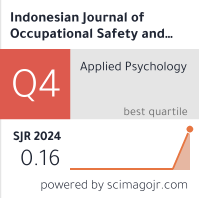Musculoskeletal Disorders and Its Related Factors among Workers in Circulator Loom Unit
Downloads
Introduction: Musculoskeletal Disorders (MSDs) defined as a disorder of muscles, nerves, and tendons compounded by the unergonomic working posture. Workers in CirculatorLoomUnit of PT. Kerta Rajasa Raya are at risk for experiencing MSDs because of their unergonomic works. The purpose of this research was to learn more about MSDs including its related factors in Circulator Loom unit of PT. Kerja Rajasa Raya workers. Methods: this was a descriptive research which conducted using the observational method. The respondents were total population workers of Circulator Loom Unit at PT Kerta Rajasa Raya which is up to 47 workers. This research used MSDs complaint, working postures, and individual factors including age, sex, working period, physical fitness, and body mass index as the variable data. Results: 91.5% respondents were experiencing MSDs with 53.5% were in moderate severity level. Using REBA method to calculate the ergonomic risk level, it can be concluded that 23.4% of respondents have low risk of experiencing MSDs, 68.1% in medium risk, and 8.5% of respondents were having high risk of experiencing MSDs. Conclusion: working posture was the most influential factor causing MSDs with correlation coefficient score 0.629, in addition, working period, age, sex, Body Mass Index, and physical fitness were existed as supporting factors.
Keywords: ergonomic, musculoskeletal disorders, working posture
Batti'e, M. et al. (1898) ‘Isometric Lifting Strength As a Predictor of Industrial Back Pain Reports', Spine, 14(8), pp. 851–856.
Bureau of Labor Statistic (2017) 2016 Survey of Occupational Injuries & Illnesses Charts Package. Washington DC: United States Department of Labor.
Caspersen, C. J., Powell, K. E. and Christenson, G. M. (1985) ‘Physical Activity , Exercise , and Physical Fitness : Definitions and Distinctions for Health-Related Research', Publich Health Report, 100(2), pp. 126–131.
Claggett, C. L. (2002) An Analysis of the Prevalence of Musculoskeletal Disorders in Heavy, Civil Construction Operation and the Impact of Job, Age, and Experience. Research Paper. Memomonie: Masters of Science Degree, University of Wisconsin-Stout.
Das, S. K. and Mukhopadhyay, S. (2016) ‘Effect of Altered Body Composition on Musculoskeletal Disorders in Medical Practitioners', International Journal of Research in Engineering and Technology, 5(16), pp. 1–6.
Ghosh, T. (2015) ‘Assessment of Postural Effect on Work Related Musculoskeletal Disorders and Back Muscle Fatigue among the Goldsmiths of India', International Journal of Occupational Safety and Health, 5(2), pp. 16–22.
Häkkänen, M., Viikari-Juntura, E. and Martikainen, R. (2001) ‘Job experience, Work Load, and Risk of Musculoskeletal Disorders', Occupational and Environmental Medicine, 58(2), pp. 129–135. doi: 10.1136/oem.58.2.129.
Health and Safety Executive (2017) ‘Work-related Musculoskeletal Disorders (WRMSDs) Statistics in Great Britain 2017'. Liverpool: Health and Safety Executive.
International Labour Organization (2013) ‘Occupational Safety and Health: Means for Productivity'. Geneva: International Labour Organization.
Khudhir, K. et al. (2017) ‘Association Between Work-Relate Musculoskeletal Disorder and Ergonomic Risk Factors Among Nursing Professionals in Ranya and Qaladiza Districts', Kurdistan Journal of Applied Research, 2(2), pp. 1–6.
Pratama, D. N. (2017) ‘Identifikasi Risiko Musculoskeletal Disorders (MSDs) Pada Pekerja Pandai Besi', The Indonesian Journal of Occupational Safety and Health, 6(1), pp. 78–87.
Randang, M. J., Kawatu, P. A. T. and Sumampouw, O. J. (2017) ‘Hubungan antara Umur, Masa Kerja dan Lama Kerja dengan Keluhan Musculoskeletal pada Nelayan di Desa Talikuran Kecamatan Remboken Kabupaten Minahasa', Media Kesehatan, 9(3), pp. 1–8.
Santosa, A. and Ariska, D. K. (2018) ‘Faktor-faktor yang Berhubungan dengan Kejadian Musculoskeletal Disorders pada Pekerja Batik di Kecamatan Sokaraja Banyumas', MEDISAINS: Jurnal Ilmiah Ilmu-ilmu Kesehatan, 16(1), pp. 42–46.
Sethi, J., Sandhu, J. S. and Imbanathan, V. (2011) ‘Effect of Body Mass Index on Work Related Musculoskeletal Discomfort and Occupational Stress of Computer Workers in a Developed Ergonomic Setup', Sports Medicine, Arthroscopy, Rehabilitation, Therapy & Technology, 3(22), pp. 1–7.
Tarwaka (2013) Ergonomi Industri: Dasar-Dasar Pengetahuan Ergonomi dan Aplikasi di Tempat Kerja. Solo: Harapan Press.
Timiras, P. S. and Navazio, F. M. (2008) ‘The Skeleton, Joints, and Skeletal and Cardiac Muscles', in Physiological Basis of Aging and Geriatrics. 4th edn. Florida: CRC Press.

In order to be accepted and published by The Indonesian Journal of Occupational Safety and Health, Author(s) who submit an article should complete all the review process. The copyright of received articles assigned to the The Indonesian Journal of Occupational Safety and Health and Department of Safety and Health, Universitas Airlangga as publishers of the journal. The intended copyright includes the rights to publish articles in various forms (including reprints).
The Editorial Team of The Indonesian Journal Of Occupational Safety and Health and Department of Safety and Health strive to ensure that no errors occur in the articles that have been published, both data errors and statements in the article.
Users of this website will be licensed to use materials from this website following the Creative Commons Attribution-NonCommercial-ShareAlike 4.0 International License. No fees charged. Please use the materials accordingly.
------------------------------------------------------------------------------------------------------------------------------------------------------------------------------------------
Attribution ” You must give appropriate credit, provide a link to the license, and indicate if changes were made. You may do so in any reasonable manner, but not in any way that suggests the licensor endorses you or your use.
NonCommercial ” You may not use the material for commercial purposes.
ShareAlike ” If you remix, transform, or build upon the material, you must distribute your contributions under the same license as the original.







 How to Submit Articles in OJS
How to Submit Articles in OJS

























